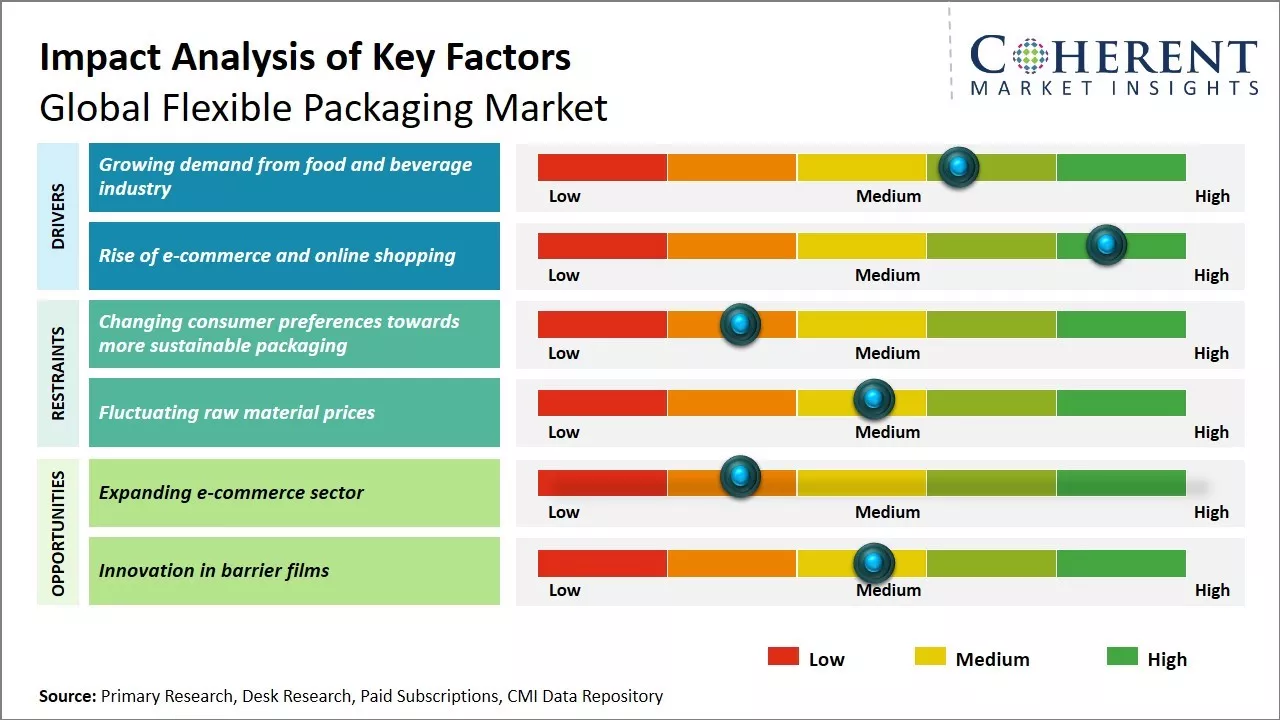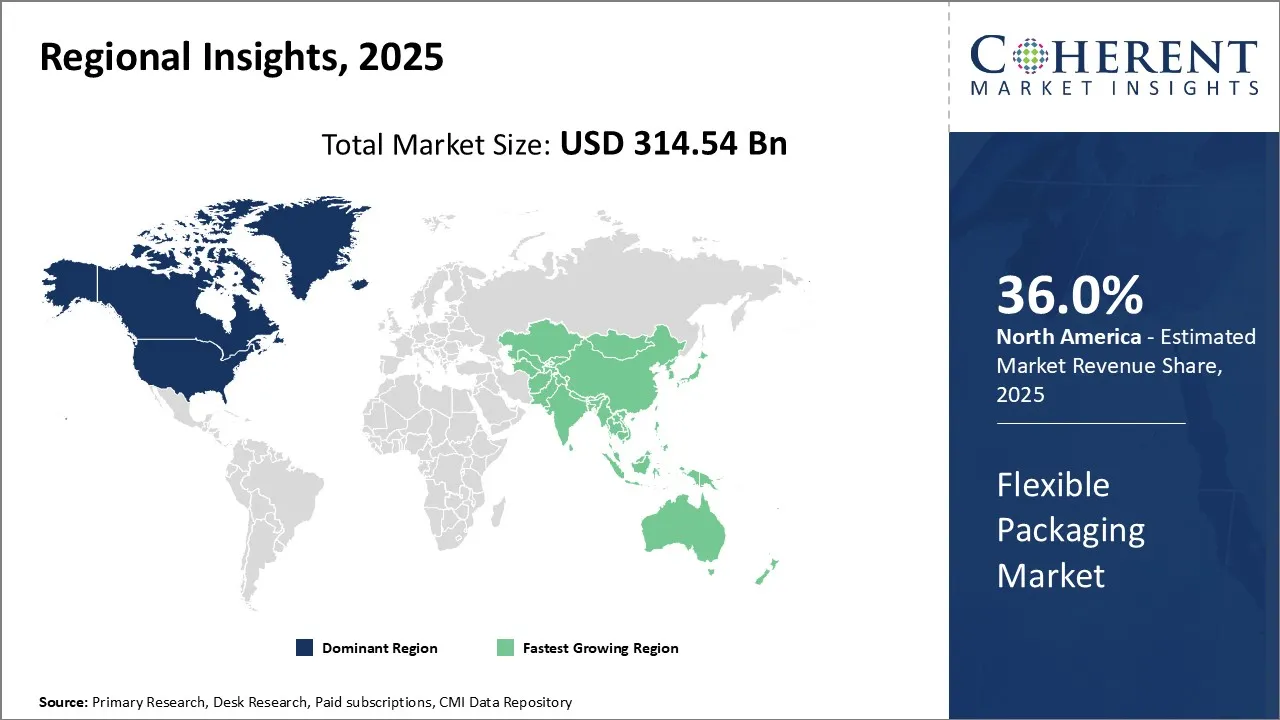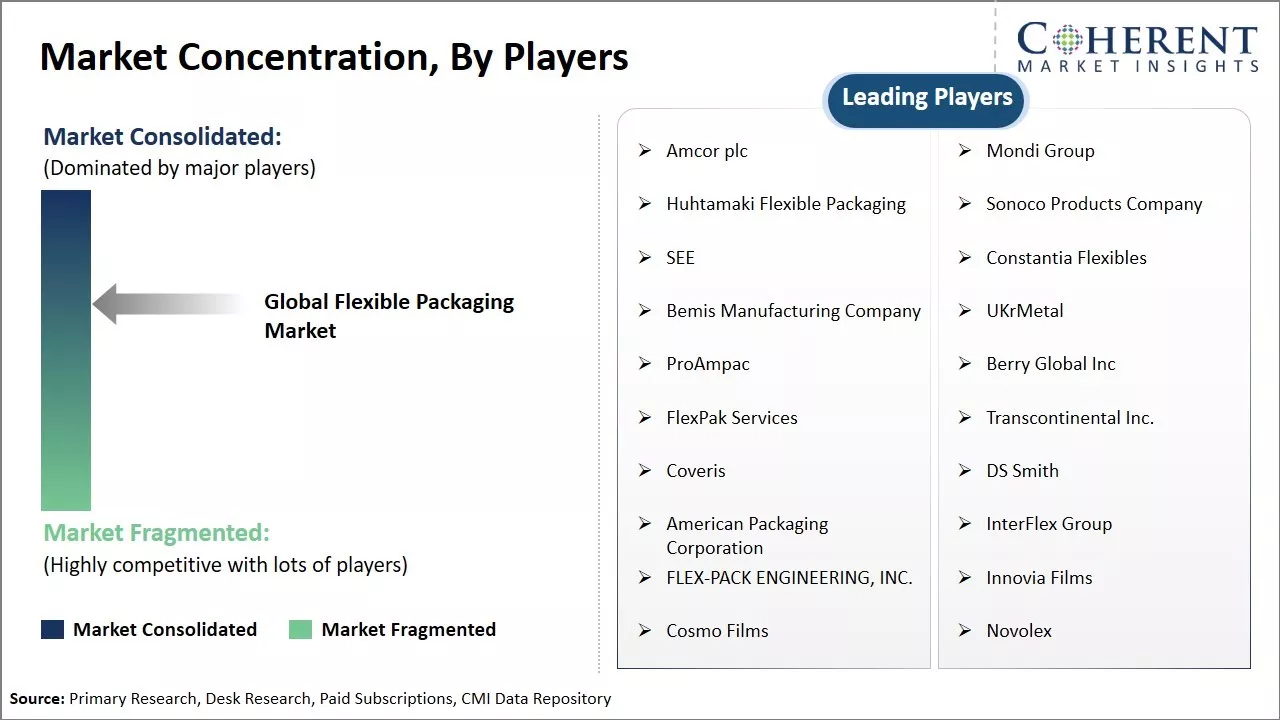The global flexible packaging market is estimated to be valued at USD 314.54 Bn in 2025 and is expected to reach USD 457.85 Bn by 2032, growing at a compound annual growth rate (CAGR) of 5.5% from 2025 to 2032.

To learn more about this report, Download Free Sample
The increasing demand for flexible packaging from the food & beverage industry is the major factor driving the market growth. Flexible packaging provides advantages like durability, lightweight, and reusability. Moreover, flexible packaging produces less waste and uses fewer resources compared to rigid packaging. Rising environmental concerns are increasing the demand for flexible packaging as it is recyclable and produces less garbage. The growing e-commerce industry globally is another factor fueling the growth of the flexible packaging market. However, the availability of substitutes like molded fiber packaging and paper bags may hinder the market growth of flexible packaging.
|
Current Event |
Description and its Impact |
|
Extended Producer Responsibility Regulatory Framework Implementation and Multi-Jurisdictional Compliance Architecture |
|
|
Sustainability Imperatives, Circular Economy Transition, and Material Innovation Acceleration |
|
Uncover macros and micros vetted on 75+ parameters: Get instant access to report
Smart packaging is transforming the flexible packaging market in 2025 by integrating intelligence, sustainability, and functionality to meet evolving consumer and industry demands.
In the flexible packaging sector, smart packaging refers to solutions that incorporate features like sensors, indicators, QR codes, and responsive materials to enhance product safety, traceability, and user engagement. These technologies are increasingly used in food, pharmaceuticals, and personal care products to monitor freshness, detect tampering, and provide real-time information to consumers. For instance, time-temperature indicators help ensure cold chain integrity, while interactive packaging with scannable codes offers transparency and brand storytelling.
The rise of e-commerce and regulatory pressures has accelerated the adoption of smart packaging, especially in flexible formats like pouches and films, which are lightweight and adaptable. Additionally, the push for sustainability has led to innovations in bio-based sensors and recyclable smart labels, aligning with circular economy goals. Brands are leveraging these advancements to reduce waste, improve supply chain efficiency, and enhance consumer trust.
As flexible packaging continues to dominate due to its convenience and cost-effectiveness, smart packaging is no longer a niche innovation but a strategic imperative. It bridges the gap between digital and physical experiences, making packaging not just a container, but a communicative and protective tool in the product lifecycle.
For instance, in October 2025, SmartSolve launched Purenil-0, the world’s first plastic-free, 100% bio-based, and flushable packaging substrate. Designed for zero-waste flexible packaging, Purenil-0 offers water-soluble and compostable properties, making it ideal for sustainable applications. This innovation marks a major step toward smart, eco-friendly packaging solutions that align with circular economy goals and consumer demand for green alternatives.
In terms of material, plastic contributes 37.3% of the market share in 2025 of the market owning to its affordability and variety of applications. Being a versatile material, plastic can be easily molded into various forms and shapes. This allows flexible plastic packaging to protect a wide range of products across industries.
From food and beverages to pharmaceuticals and personal care, plastic packaging fulfills the needs of numerous ends uses effectively. The affordability of plastic makes it an attractive solution for both manufacturers and consumers. Compared to other materials like paper and metal, plastic has a lower raw material and production cost. This cost-efficiency enables companies to package their goods at reasonable prices without major impact on profit margins.
Lower packaging costs are eventually passed on to consumers in the form of affordable prices. Affordability facilitates greater product accessibility, growing plastic's applicability. Plastic materials like polyethylene (PE), polypropylene (PP), and polyethylene terephthalate (PET) offer advantages like durability, printability, and moisture resistance. Their barrier properties protect the products from external factors like humidity and contamination.
Plastic resins also give packaging designers creative freedom to develop custom container shapes, sizes, and graphics as per brand needs. This drives brand differentiation and marketing on shelves. The development of bio-plastic variants has further augmented plastic's versatility. Bio-plastics derived from renewable plant-based sources bring the same functionality with lower eco-footprint. Their biodegradability addresses sustainability concerns regarding plastic waste. Such innovations will aid plastic's continued dominance in the packaging spectrum.
For instance, in September 2025, TIPA unveiled a breakthrough in compostable packaging, introducing a transparent laminate that mimics conventional plastic while remaining fully compostable. This innovation enables high-performance, eco-friendly flexible packaging for food and fashion applications, aligning with global sustainability goals and regulatory shifts. The development marks a significant step toward replacing petroleum-based films with biodegradable alternatives.
In terms of product type, stand-up pouches segment contributes 31.8% of the market share in 2025. Stand-up pouches maximize space utilization due to their three-dimensional shape. More product can be packed in lesser space, improving load per truck or shipping container. This directly cuts transportation and logistics costs. Being self-standing, stand-up pouches do not require extra packaging material like boxes. Their peel-open feature provides easy access to contents without additional utensils like boxes. This enhances consumer convenience during use.
Stand-up pouches are ideally suited for powders, liquids and snacks which are accessed regularly. From a manufacturing point of view, stand-up pouches require less raw material compared to rigid alternatives. Their use of laminated web rolls and form-fill-seal technology makes production highly automated with better speeds. This reduces per piece costs. Stand-up pouches are recyclable and optionally come with re-sealable zippers or pouring fits depending on product needs.
Brands recognize the shelf-popping visibility provided by stand-up pouches due to their upright showcase format. Vibrant graphics and customer messaging can be leveraged for strong on-shelf appeal and impulse buying. Top brands across food, pet care, and other segments are switching to stand-up pouches for their competitive edge in busy retail aisles.
For instance, in February 2025, Mondi and Proquimia launched paper-based stand-up pouches for dishwashing tablets, replacing traditional plastic packaging with recyclable fiber-based alternatives. The innovation supports sustainability goals while maintaining product protection and shelf appeal. This marks a significant advancement in eco-friendly flexible packaging for home care products, aligning with growing consumer demand and regulatory pressure for recyclable materials.
In terms of application, the food & beverage segment contributes 37% share of the market in 2025 owing to extensive packaging needs. As lifestyles evolve with changing consumer demands, the packaging format preferences are also undergoing rapid change. Flexible pouches and bags fit the bill perfectly. From snacks to frozen meals and pet food, flexible packaging variations like stand-up pouches, spiral wound bags, and flow-wraps pack diversity. Their barrier properties protect contents across the fresh, frozen, and perishable categories.
Beverage manufacturers leverage flexible packs for point-of-sale shipment and store displays. Pouches and aseptic bags enable the transport of liquids while occupying less space than glass or rigid containers. Shelf-stable formats keep products fresh. Customizable bag-in-box solutions benefit food service players. Flexible laminates and coextrusions meet regulatory standards for direct food contact.
Rising health-consciousness is shifting diets towards portable packaged products with transparent labeling. Flexible pouches cater to this lifestyle need through functional attributes like re-closability, dip-spoon inserts, and dispensing nozzles. Their applications in nutraceuticals, vitamins, and meal replacement supplements also see strong growth.
The growing frozen food segment looks up to flexible laminates barrier properties against moisture, oxygen, and light. This helps extend the shelf-life of ready-to-cook meals, vegetables, and snacks without refrigerator needed at point-of-sale or consumption. Given the diverse packaging demand, the food and beverage industry will continue powering the flexible packaging market.
For instance, in June 2025, UFlex Ltd launched a single-pellet rPET solution for food and beverage packaging, streamlining production of sustainable flexible packaging. The innovation combines recycled content with food-grade compliance, reducing complexity for converters and supporting circular economy goals. This marks a significant step toward scalable, eco-friendly packaging in high-volume consumer segments.

To learn more about this report, Download Free Sample
North America remains the leading region in the global flexible packaging market with 36.0% of the market share in 2025, driven by strong demand from various end-use industries such as food and beverages, pharmaceuticals, personal care, and cosmetics. The flexible packaging industry has a significant presence in the U.S. owing to well-established manufacturing facilities of major players and availability of cutting-edge technologies. Additionally, growing consumption of packaged and processed food have accelerated the uptake of flexible plastic films and pouches in the food industry. Moreover, the U.S. is a leading exporter of flexible packages to other countries due to stringent waste management regulations, which mandate the use of lightweight and recyclable packaging materials.
For instance, in August 2025, ProAmpac commercialized a high-performance recyclable packaging solution for chunk cheese, expanding its ProActive Recyclable® portfolio. Designed for food safety and shelf life, the mono-material polyethylene structure offers moisture and oxygen barriers while supporting sustainability goals. This innovation enhances flexible packaging options for dairy products, aligning with growing demand for recyclable food-grade materials in the U.S. market.
Asia Pacific has emerged as the fastest growing regional market for flexible packaging over the past few years. Rapid industrialization and rising disposable incomes have augmented the demand for packaged goods across nations such as India and China. The expanding middle-class population is inclined toward packaged foods and beverages, which has spurred flexible packaging consumption. Domestic manufacturers are continuously enhancing their production capabilities through the acquisition of new machinery and equipment. Local players are engaged in import substitution to establish a robust supply chain within the region. In addition, the growing import and export of goods within Asia Pacific and from other regions has augmented the demand for flexible packages used in industrial packaging. Emerging economies offer attractive growth opportunities to flexible packaging companies given their aggressive market expansion strategies.
For instance, in September 2025, Borouge, Siegwerk, and TPN Food Packaging launched a fully recyclable mono-material packaging solution for food applications. Combining Borouge’s polyethylene with Siegwerk’s recyclable inks and coatings, the innovation supports circular economy goals and enhances sustainability in flexible packaging. This collaboration marks a significant step toward scalable, eco-friendly packaging in the food industry.
The U.S. flexible packaging market is booming in 2025 due to rising e-commerce, demand for lightweight and sustainable materials, and regulatory pressure for recyclable solutions. Innovations in bioplastics and mono-materials, coupled with consumer preference for convenience and eco-friendly packaging, are driving growth across food, beverage, and personal care sectors.
For instance, in August 2025, A coalition of major U.S. brands launched the Flexible Film Initiative to advance recycling of post-consumer flexible packaging. Led by Nestlé, PepsiCo, Mars, and others, the non-profit aims to build a scalable, circular system through demonstration projects and policy development. The initiative addresses sustainability challenges in food and consumer goods packaging.
China’s flexible packaging market is growing in 2025 due to rising demand for convenient, lightweight, and sustainable packaging across food, beverage, and pharmaceutical sectors. Urbanization, e-commerce expansion, and government regulations promoting recyclable materials are driving innovation in mono-materials, compostables, and barrier films, making flexible formats increasingly preferred by manufacturers and consumers alike.
For instance, in October 2025, Henkel launched Recyclab in China, a pioneering initiative to create a sustainable packaging ecosystem. Focused on recyclable solutions, Recyclab promotes innovation in mono-materials and eco-friendly adhesives for flexible packaging. The program supports circular economy goals and aligns with China’s push for greener consumer goods packaging across food, personal care, and household sectors.
| Report Coverage | Details | ||
|---|---|---|---|
| Base Year: | 2024 | Market Size in 2025: | USD 314.54 Bn |
| Historical Data for: | 2020 To 2024 | Forecast Period: | 2025 To 2032 |
| Forecast Period 2025 to 2032 CAGR: | 5.5% | 2032 Value Projection: | USD 457.85 Bn |
| Geographies covered: |
|
||
| Segments covered: |
|
||
| Companies covered: |
Amcor plc, Mondi Group, Huhtamaki Flexible Packaging, Sonoco Products Company, SEE, Constantia Flexibles, Bemis Manufacturing Company, UKrMetal, ProAmpac, Berry Global Inc, FlexPak Services, Transcontinental Inc., Coveris, DS Smith, American Packaging Corporation, InterFlex Group, FLEX-PACK ENGINEERING, INC., Innovia Films, Cosmo Films, and Novolex |
||
| Growth Drivers: |
|
||
| Restraints & Challenges: |
|
||
Uncover macros and micros vetted on 75+ parameters: Get instant access to report
The food and beverage industry is increasingly adopting flexible packaging formats for their products. Flexible packaging is highly suitable for the food and beverage industry as it protects products from damage, provides longer shelf life, and enhances product appeal through colorful printing options. Flexible formats like stand-up pouches, shrink films, and wraps are lightweight, easy to transport, and use less material. They provide similar or better protection compared to rigid packaging formats. This makes flexible packaging an economical and sustainable solution for food manufacturers and retailers. Given the growing demand for packaged and ready-to-eat foods across regions, flexible packaging manufacturers are continuously innovating their product offerings to cater to the changing needs of food companies. Stand-up pouches are being introduced for various powdered mixes and snacks owing to their strong barrier properties and ability to stand independently on shelves. Retort packaging which can withstand high temperatures is gaining popularity for ready meals. Multilayer films are utilized for fresh meat, seafood, and bakery items to increase shelf life. Companies are also incorporating advanced digital printing on flexible films to replicate the designs of rigid jars and enhance the package appeal. Thus, evolving packaging needs as well as increased consumption of packaged foods and beverages is expected to drive significant demand for flexible packaging formats in the coming years.

To learn more about this report, Download Free Sample
The proliferation of e-commerce and rise of online shopping platforms across the world has opened significant opportunities for the flexible packaging market. While rigid packaging remains suitable for durable goods, flexible packaging formats are highly preferable for shipping and delivering varied products through online channels. Flexible pouches, bags, and wraps provide effective protection to products during transportation while ensuring minimum shipping costs due to optimum space utilization and lightweight nature. Their sealing ability also prevents damage and product spillage compared to rigid containers. Flexible packaging manufacturers are thus developing formats and materials customized for secure delivery of apparel, cosmetics, stationery and other consumer goods via online shopping. Specialty mailing bags, vinyl woven bags, zipper pouches, and kraft paper wraps with reinforced edges are some innovations witnessed. Digital printing facilitated personalized designing of packaging according to merchant and delivery brand identity. Flexible packaging plays a pivotal role in enhancing the unboxing experience for online customers and building merchant credibility. Their sustainable credentials also align well with the green priorities of e-tailers and logistics companies.
The expanding e-commerce sector fuels the demand for effective packaging solutions for shipping products. Growth in industries like food and beverages, pharmaceuticals, and personal care drives the need for packaged goods. Flexible packaging offers advantages over rigid alternatives in terms of cost effectiveness and ability to extend product shelf life.
The flexible packaging market value is undergoing a structural shift driven by stringent recyclability regulations and material innovation. Regulatory frameworks such as the EU Packaging and Packaging Waste Regulation (PPWR), mandating 65% packaging recycling by 2030, are accelerating the move toward circular, mono-material solutions. Polyethylene and polypropylene-based mono-material pouches are gaining traction as they meet recycling requirements without compromising barrier strength or machinability. For instance, Amcor’s AmLite HeatFlex recyclable retort pouch demonstrates lifecycle carbon savings versus traditional multi-material formats.
Global consumer goods leaders like Nestlé and Unilever are enforcing supplier standards tied to recyclable formats and investing in recycling infrastructure, thereby creating a pull-effect across the supply chain. Plastic-based structures still dominate over 60% of flexible packaging, underscoring the urgency to redesign legacy formats for compliance and sustainability. Firms prioritizing recyclable mono-material films and integrated recycling partnerships are likely to capture long-term advantage, while laggards risk exclusion from major retail supply chains.
Ultimately, commercial success now depends on proving both performance and circularity. Companies integrating design innovation, recycling collaborations, and lifecycle cost transparency will secure stronger brand partnerships and regulatory alignment, defining the next competitive frontier of the global flexible packaging market.
Share
Share
About Author
Kalpesh Gharte is a senior consultant with approximately 5 years of experience in the consulting industry. Kalpesh holds an MBA in Operations and Marketing Management, providing him with a strong foundation in market strategy and analysis. He has contributed to various consulting and syndicated reports, delivering valuable insights that support informed business decisions
Missing comfort of reading report in your local language? Find your preferred language :
Transform your Strategy with Exclusive Trending Reports :
Frequently Asked Questions
Joining thousands of companies around the world committed to making the Excellent Business Solutions.
View All Our Clients